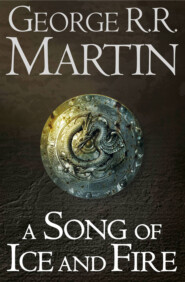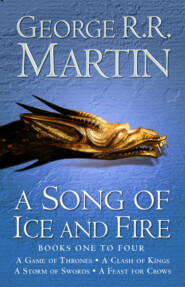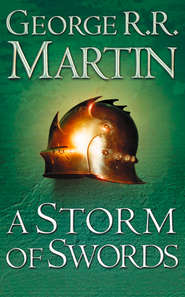По всем вопросам обращайтесь на: info@litportal.ru
(©) 2003-2024.
✖
Fire and Blood
Год написания книги
2019
Настройки чтения
Размер шрифта
Высота строк
Поля
Soon only Lord Tyrell and his host remained. King Aegon had left Tyrell behind when he departed. Hellholt, a strong castle on the river Brimstone, was thought to be well situated to deal with any revolts. But the river was sulfurous, and the fish taken from it made the Highgardeners sick. House Qorgyle of Sandstone had never submitted, and Qorgyle spearmen cut down Tyrell’s foraging parties and patrols whenever they strayed too far west. The Vaiths of Vaith did the same to the east. When word of the Defenestration of Sunspear reached the Hellholt, Lord Tyrell gathered his remaining strength and set off across the sands. His announced intention was to capture Vaith, march east along the river, retake Sunspear and the shadow city, and punish Lord Rosby’s murderers. But somewhere east of the Hellholt amidst the red sands, Tyrell and his entire army disappeared. No man of them was ever seen again.
Aegon Targaryen was not a man to accept defeat. The war would drag on for another seven years, though after 6 AC the fighting degenerated into an endless bloody series of atrocities, raids, and retaliations, broken up by long periods of inactivity, a dozen short truces, and numerous murders and assassinations.
In 7 AC, Orys Baratheon and the other lords who had been taken captive on the Boneway were ransomed back to King’s Landing for their weight in gold, but on their return it was found that the Widow-lover had lopped off each man’s sword hand, so they might never again take up swords against Dorne. In retaliation, King Aegon himself descended on the mountain fastnesses of the Wyls with Balerion, and reduced half a dozen of their keeps and watchtowers to heaps of molten stone. The Wyls took refuge in caves and tunnels beneath their mountains, however, and the Widow-lover lived another twenty years.
In 8 AC, a very dry year, Dornish raiders crossed the Sea of Dorne on ships provided by a pirate king from the Stepstones, attacking half a dozen towns and villages along the south shore of Cape Wrath and setting fires that spread through half the rainwood. “Fire for fire,” Princess Meria is reported to have said.
This was not something the Targaryens would allow to go unanswered. Later that same year, Visenya Targaryen appeared in the skies of Dorne, and Vhagar’s fires were loosed upon Sunspear, Lemonwood, Ghost Hill, and the Tor.
In 9 AC, Visenya returned again, this time with Aegon himself flying beside her, and Sandstone, Vaith, and the Hellholt burned.
The Dornish answer came the next year, when Lord Fowler led an army through the Prince’s Pass and into the Reach, moving so swiftly that he was able to burn a dozen villages and capture the great border castle Nightsong before the marcher lords realized the foe was upon them. When word of the attack reached Oldtown, Lord Hightower sent his son Addam with a strong force to retake Nightsong, but the Dornish had anticipated just that thing. A second Dornish army under Ser Joffrey Dayne came down from Starfall and attacked the city. Oldtown’s walls proved too strong for the Dornish to overcome, but Dayne burned fields, farms, and villages for twenty leagues around the city, and slew Lord Hightower’s younger son, Garmon, when the boy led a sortie against him. Ser Addam Hightower reached Nightsong only to find that Lord Fowler had put the castle to the torch and its garrison to the sword. Lord Caron and his wife and children had been carried back to Dorne as captives. Rather than pursue, Ser Addam returned at once to Oldtown to relieve the city, but Ser Joffrey and his army had melted back into the mountains as well.
Old Lord Manfred Hightower died soon after. Ser Addam succeeded his father as the Lord of the High Tower, as Oldtown cried out for vengeance. King Aegon flew Balerion to Highgarden to take counsel with his Warden of the South, but Theo Tyrell, the young lord, was most reluctant to contemplate another invasion of Dorne after the fate that had befallen his father.
Once again the king unleashed his dragons against Dorne. Aegon himself fell upon Skyreach, vowing to make the Fowler seat “a second Harrenhal.” Visenya and Vhagar brought fire and blood to Starfall. And Rhaenys and Meraxes returned once more to the Hellholt … where tragedy struck. The Targaryen dragons, bred and trained to battle, had flown through storms of spears and arrows on many occasions, and suffered little harm. The scales of a full-grown dragon were harder than steel, and even those arrows that struck home seldom penetrated enough to do more than enrage the great beasts. But as Meraxes banked above the Hellholt, a defender atop the castle’s highest tower triggered a scorpion, and a yard-long iron bolt caught the queen’s dragon in the right eye. Meraxes did not die at once, but came crashing to earth in mortal agony, destroying the tower and a large section of the Hellholt’s curtain wall in her death throes.
Whether Rhaenys Targaryen outlived her dragon remains a matter of dispute. Some say that she lost her seat and fell to her death, others that she was crushed beneath Meraxes in the castle yard. A few accounts claim the queen survived her dragon’s fall, only to die a slow death by torment in the dungeons of the Ullers. The true circumstances of her demise will likely never be known, but Rhaenys Targaryen, sister and wife to King Aegon I, perished at the Hellholt in Dorne in the 10th year After the Conquest.
The next two years were the years of the Dragon’s Wroth. Every castle in Dorne was burned thrice over, as Balerion and Vhagar returned time and time again. The sands around the Hellholt were fused into glass in places, so hot was Balerion’s fiery breath. The Dornish lords were forced into hiding, but even that did not buy them safety. Lord Fowler, Lord Vaith, Lady Toland, and four successive Lords of the Hellholt were murdered, one after the other, for the Iron Throne had offered a lord’s ransom in gold for the head of any Dornish lord. Only two of the killers lived to collect their rewards, however, and the Dornishmen took their reprisals, repaying blood with blood. Lord Connington of Griffin’s Roost was killed whilst hunting, Lord Mertyns of Mistwood poisoned with his whole household by a cask of Dornish wine, Lord Fell smothered in a brothel in King’s Landing.
Nor were the Targaryens themselves exempt. The king was attacked thrice, and would have fallen on two of those occasions but for his guards. Queen Visenya was set upon one night in King’s Landing. Two of her escorts were slain before Visenya herself cut down the last attacker with Dark Sister.
The most infamous act of that bloody age occurred in 12 AC, when Wyl of Wyl, the Widow-lover, arrived uninvited at the wedding of Ser Jon Cafferen, heir to Fawnton, to Alys Oakheart, daughter to the Lord of Old Oak. Admitted through a postern gate by a treacherous servant, the Wyl attackers slew Lord Oakheart and most of the wedding guests, then made the bride look on as they gelded her husband. Afterward they took turns raping Lady Alys and her handmaids, then carried them off and sold them to a Myrish slaver.
By then Dorne was a smoking desert, beset by famine, plague, and blight. “A blasted land,” traders from the Free Cities called it. Yet House Martell still remained Unbowed, Unbent, Unbroken, as their words avowed. One Dornish knight, brought before Queen Visenya as a captive, insisted that Meria Martell would sooner see her people dead than slaves to House Targaryen. Visenya replied that she and her brother would be glad to oblige the princess.
Age and ill health finally did what dragons and armies could not. In 13 AC, Meria Martell, the Yellow Toad of Dorne, died abed (whilst having intimate relations with a stallion, her enemies insisted). Her son Nymor succeeded her as Lord of Sunspear and Prince of Dorne. Sixty years old, his health already failing, the new Dornish prince had no appetite for further slaughter. He began his reign by sending a delegation to King’s Landing, to return the skull of the dragon Meraxes and offer King Aegon terms of peace. His own heir, his daughter Deria, led the embassy.
Prince Nymor’s peace proposals encountered strong opposition in King’s Landing. Queen Visenya was hard set against them. “No peace without submission,” she declared, and her friends on the king’s council echoed her words. Orys Baratheon, who had grown bent and bitter in his later years, argued for sending Princess Deria back to her father less a hand. Lord Oakheart sent a raven, suggesting that the Dornish girl be sold into “the meanest brothel in King’s Landing, till every beggar in the city has had his pleasure of her.” Aegon Targaryen dismissed all such proposals; Princess Deria had come as an envoy under a banner of peace and would suffer no harm under his roof, he vowed.
The king was weary of war, all men agreed, but granting the Dornishmen peace without submission would be tantamount to saying that his beloved sister Rhaenys had died in vain, that all the blood and death had been for naught. The lords of his small council further cautioned that any such peace could be seen as a sign of weakness and might encourage fresh rebellions, which would then need to be put down. Aegon knew that the Reach, the stormlands, and the marches had suffered grievously during the fighting, and would neither forgive nor forget. Even in King’s Landing, the king dared not let the Dornish outside the Aegonfort without a strong escort, for fear that the smallfolk of the city would tear them to pieces. For all these reasons, Grand Maester Lucan wrote later, the king was on the point of refusing the Dornish proposals and continuing the war.
It was then that Princess Deria presented the king with a sealed letter from her father. “For your eyes only, Your Grace.”
King Aegon read Prince Nymor’s words in open court, stone-faced and silent, whilst seated on the Iron Throne. When he rose afterward, men said, his hand was dripping blood. He burned the letter and never spoke of it again, but that night he mounted Balerion and flew off across the waters of Blackwater Bay, to Dragonstone upon its smoking mountain. When he returned the next morning, Aegon Targaryen agreed to the terms proposed by Nymor. Soon thereafter he signed a treaty of eternal peace with Dorne.
To this day, no one can say with certainty what might have been in Deria’s letter. Some claim it was a simple plea from one father to another, heartfelt words that touched King Aegon’s heart. Others insist it was a list of all those lords and noble knights who had lost their lives during the war. Certain septons even went so far as to suggest that the missive was ensorceled, that it had been written by the Yellow Toad before her death, using a vial of Queen Rhaenys’s own blood for ink, so that the king would be helpless to resist its malign magic.
Grand Maester Clegg, who came to King’s Landing many years later, concluded that Dorne no longer had the strength to fight. Driven by desperation, Clegg suggested, Prince Nymor might have threatened that, should his peace be refused, he would engage the Faceless Men of Braavos to kill King Aegon’s son and heir, Queen Rhaenys’s boy, Aenys, then but six years old. It may be so … but no man will ever truly know.
Thus ended the First Dornish War (4–13 AC).
The Yellow Toad of Dorne had done what Harren the Black, the Two Kings, and Torrhen Stark could not; she had defeated Aegon Targaryen and his dragons. Yet north of the Red Mountains, her tactics earned her only scorn. “Dornish courage” became a mocking name for cowardice amongst the lords and knights of Aegon’s kingdoms. “The toad hops into her hole when threatened,” wrote one scribe. Another said, “Meria fought like a woman, with lies and treachery and witchery.” The Dornish “victory” (if victory it was) was seen to be dishonorable, and the survivors of the fight, and the sons and brothers of those who had fallen, promised one another that another day would come, and with it a reckoning.
Their vengeance would need to wait for a future generation, and the accession of a younger, more bloodthirsty king. Though he would sit the Iron Throne for another twenty-four years, the Dornish conflict was Aegon the Conqueror’s last war.
Three Heads Had the Dragon
Governance Under King Aegon I
Aegon I Targaryen was a warrior of renown, the greatest Conqueror in the history of Westeros, yet many believe his most significant accomplishments came during times of peace. The Iron Throne was forged with fire and steel and terror, it is said, but once the throne had cooled, it became the seat of justice for all Westeros.
The reconciliation of the Seven Kingdoms to Targaryen rule was the keystone of Aegon I’s policies as king. To this end, he made great efforts to include men (and even a few women) from every part of the realm in his court and councils. His former foes were encouraged to send their children (chiefly younger sons and daughters, as most great lords desired to keep their heirs close to home) to court, where the boys served as pages, cupbearers, and squires, the girls as handmaidens and companions to Aegon’s queens. In King’s Landing, they witnessed the king’s justice at first hand, and were urged to think of themselves as leal subjects of one great realm, not as westermen or stormlanders or northmen.
The Targaryens also brokered many marriages between noble houses from the far ends of the realm, in hopes that such alliances would help tie the conquered lands together and make the seven kingdoms one. Aegon’s queens, Visenya and Rhaenys, took a special delight in arranging these matches. Through their efforts, young Ronnel Arryn, Lord of the Eyrie, took a daughter of Torrhen Stark of Winterfell to wed, whilst Loren Lannister’s eldest son, heir to Casterly Rock, married a Redwyne girl from the Arbor. When three girls, triplets, were born to the Evenstar of Tarth, Queen Rhaenys arranged betrothals for them with House Corbray, House Hightower, and House Harlaw. Queen Visenya brokered a double wedding between House Blackwood and House Bracken, rivals whose history of enmity went back centuries, matching a son of each house with a daughter of the other to seal a peace between them. And when a Rowan girl in Rhaenys’s service found herself with child by a scullion, the queen found a knight to marry her in White Harbor, and another in Lannisport who was willing to take on her bastard as a fosterling.
Though none doubted that Aegon Targaryen was the final authority in all matters relating to the governance of the realm, his sisters Visenya and Rhaenys remained his partners in power throughout his reign. Save perhaps for Good Queen Alysanne, the wife of King Jaehaerys I, no other queen in the history of the Seven Kingdoms ever exercised as much influence over policy as the Dragon’s sisters. It was the king’s custom to bring one of his queens with him wherever he traveled, whilst the other remained at Dragonstone or King’s Landing, oft as not seated on the Iron Throne, ruling on whatever matters came before her.
Though Aegon had designated King’s Landing as his royal seat and installed the Iron Throne in the Aegonfort’s smoky longhall, he spent no more than a quarter of his time there. Full as many of his days and nights were spent on Dragonstone, the island citadel of his forebears. The castle below the Dragonmont had ten times the room of the Aegonfort, with considerably more comfort, safety, and history. The Conqueror was once heard to say that he even loved the scent of Dragonstone, where the salt air always smelled of smoke and brimstone. Aegon spent roughly half the year at his two seats, dividing his time between them.
The other half he devoted to an endless royal progress, taking his court from one castle to another, guesting with each of his great lords in turn. Gulltown and the Eyrie, Harrenhal, Riverrun, Lannisport and Casterly Rock, Crakehall, Old Oak, Highgarden, Oldtown, the Arbor, Horn Hill, Ashford, Storm’s End, and Evenfall Hall had the honor of hosting His Grace many times, but Aegon could and would turn up almost anywhere, sometimes with as many as a thousand knights and lords and ladies in his train. He journeyed thrice to the Iron Islands (twice to Pyke and once to Great Wyk), spent a fortnight at Sisterton in 19 AC, and visited the North six times, holding court thrice in White Harbor, twice at Barrowton, and once at Winterfell on his very last royal progress in 33 AC.
“It is better to forestall rebellions than to put them down,” Aegon famously said, when asked the reason for his journeys. A glimpse of the king in all his power, mounted on Balerion the Black Dread and attended by hundreds of knights glittering in silk and steel, did much to instill loyalty in restless lords. The smallfolk needed to see their kings and queens from time to time as well, the king added, and know that they might have the chance to lay their grievances and concerns before him.
And so they did. Much of every royal progress was given over to feasts and balls and hunts and hawking, as every lord attempted to outdo the others in splendor and hospitality, but Aegon also made a point of holding court wherever he might travel, whether from a dais in some great lord’s castle or a mossy stone in a farmer’s field. Six maesters traveled with him, to answer any questions he might have on local law, customs, and history, and to make note of such decrees and judgments as His Grace might hand down. A lord should know the land he rules, the Conqueror later told his son Aenys, and through his travels Aegon learned much and more about the Seven Kingdoms and its peoples.
Each of the conquered kingdoms had its own laws and traditions. King Aegon did little to interfere with those. He allowed his lords to continue to rule much as they always had, with all the same powers and prerogatives. The laws of inheritance and succession remained unchanged, the existing feudal structures were confirmed, lords both great and small retained the power of pit and gallows on their own land, and the privilege of the first night wherever that custom had formerly prevailed.
Aegon’s chief concern was peace. Before the Conquest, wars between the realms of Westeros were common. Hardly a year passed without someone fighting someone somewhere. Even in those kingdoms said to be at peace, neighboring lords oft settled their disputes at swordpoint. Aegon’s accession put an end to much of that. Petty lords and landed knights were now expected to take their disputes to their liege lords and abide by their judgments. Arguments between the great houses of the realm were adjudicated by the Crown. “The first law of the land shall be the King’s Peace,” King Aegon decreed, “and any lord who goes to war without my leave shall be considered a rebel and an enemy of the Iron Throne.”
King Aegon also issued decrees regularizing customs, duties, and taxes throughout the realm, whereas previously every port and every petty lord had been free to exact however much they could from tenants, smallfolk, and merchants. He also proclaimed that the holy men and women of the Faith, and all their lands and possessions, were to be exempt from taxation, and affirmed the right of the Faith’s own courts to try and sentence any septon, Sworn Brother, or holy sister accused of malfeasance. Though not himself a godly man, the first Targaryen king always took care to court the support of the Faith and the High Septon of Oldtown.
King’s Landing grew up around Aegon and his court, on and about the three great hills that stood near the mouth of the Blackwater Rush. The highest of those hills had become known as Aegon’s High Hill, and soon enough the lesser hills were being called Visenya’s Hill and the Hill of Rhaenys, their former names forgotten. The crude motte-and-bailey fort that Aegon had thrown up so quickly was neither large enough nor grand enough to house the king and his court, and had begun to expand even before the Conquest was complete. A new keep was erected, all of logs and fifty feet high, with a cavernous longhall beneath it, and a kitchen, made of stone and roofed with slate in case of fire, across the bailey. Stables appeared, then a granary. A new watchtower was raised, twice as tall as the older one. Soon the Aegonfort was threatening to burst out of its walls, so a new palisade was raised, enclosing more of the hilltop, creating space enough for a barracks, an armory, a sept, and a drum tower.
Below the hills, wharves and storehouses were rising along the riverbanks, and merchants from Oldtown and the Free Cities were tying up beside the longships of the Velaryons and Celtigars, where only a few fishing boats had previously been seen. Much of the trade that had gone through Maidenpool and Duskendale was now coming to King’s Landing. A fish market sprung up along the riverside, a cloth market between the hills. A customs house appeared. A modest sept opened on the Blackwater, in the hull of an old cog, followed by a stouter one of daub-and-wattle on the shore. Then a second sept, twice as large and thrice as grand, was built atop Visenya’s Hill, with coin sent by the High Septon. Shops and homes sprouted like mushrooms after a rain. Wealthy men raised walled manses on the hillsides, whilst the poor gathered in squalid hovels of mud and straw in the low places between.
No one planned King’s Landing. It simply grew … but it grew quickly. At Aegon’s first coronation, it was still a village squatting beneath a motte-and-bailey castle. By his second, it was already a thriving town of several thousand souls. By 10 AC, it was a true city, almost as large as Gulltown or White Harbor. By 25 AC, it had outgrown both to become the third most populous city in the realm, surpassed only by Lannisport and Oldtown.
Unlike its rivals, however, King’s Landing had no walls. It needed none, some of its residents were known to say; no enemy would ever dare attack the city so long as it was defended by the Targaryens and their dragons. The king himself might have shared these views originally, but the death of his sister Rhaenys and her dragon, Meraxes, in 10 AC and the attacks upon his own person undoubtedly gave him cause …
And in the 19th year After the Conquest, word reached Westeros of a daring raid in the Summer Isles, where a pirate fleet had sacked Tall Trees Town and carried off a thousand women and children as slaves, along with a fortune in plunder. The accounts of the raid greatly troubled the king, who realized that King’s Landing would be similarly vulnerable to any enemy shrewd enough to fall upon the city when he and Visenya were elsewhere. Accordingly, His Grace ordered the construction of a ring of walls about King’s Landing, as high and strong as those that protected Oldtown and Lannisport. The task of building them was conferred upon Grand Maester Gawen and Ser Osmund Strong, the Hand of the King. To honor the Seven, Aegon decreed that the city would have seven gates, each defended by a massive gatehouse and defensive towers. Work on the walls began the next year and continued until 26 AC.
Ser Osmund was the king’s fourth Hand. His first had been Lord Orys Baratheon, his bastard half-brother and companion of his youth, but Lord Orys was taken captive during the Dornish War and suffered the loss of his sword hand. When ransomed back, his lordship asked the king to be relieved of his duties. “The King’s Hand should have a hand,” he said. “I will not have men speaking of the King’s Stump.” Aegon next called on Edmyn Tully, Lord of Riverrun, to take up the Handship. Lord Edmyn served from 7–9 AC, but when his wife died in childbed, he decided that his children had more need of him than the realm, and begged leave to return to the riverlands. Alton Celtigar, Lord of Claw Isle, replaced Tully, serving ably as Hand until his death from natural causes in 17 AC, after which the king named Ser Osmund Strong.
Grand Maester Gawen was the third in that office. Aegon Targaryen had always kept a maester on Dragonstone, as his father and father’s father had before him. All the great lords of Westeros, and many lesser lords and landed knights, relied upon maesters trained in the Citadel of Oldtown to serve their households as healers, scribes, and counselors, to breed and train the ravens who carried their messages (and write and read those messages for lords who lacked those skills), help their stewards with the household accounts, and teach their children. During the Conquest, Aegon and his sisters each had a maester serving them, and afterward the king sometimes employed as many as half a dozen to deal with all the matters brought before him.
But the wisest and most learned men in the Seven Kingdoms were the archmaesters of the Citadel, each of them the supreme authority in one of the great disciplines. In 5 AC, King Aegon, feeling that the realm might benefit from such wisdom, asked the Conclave to send him one of their own number to advise and consult with him on all matters relating to the governance of the realm. Thus was the office of Grand Maester created, at King Aegon’s request.
The first man to serve in that capacity was Archmaester Ollidar, keeper of histories, whose ring and rod and mask were bronze. Though exceptionally learned, Ollidar was also exceptionally old, and he passed from this world less than a year after taking up the mantle of Grand Maester. To fill his place, the Conclave selected Archmaester Lyonce, whose ring and rod and mask were yellow gold. He proved more robust than his predecessor, serving the realm until 12 AC, when he slipped in the mud, broke his hip, and died soon thereafter, whereupon Grand Maester Gawen was elevated.
The institution of the king’s small council did not come into its full bloom until the reign of King Jaehaerys the Conciliator, but that is not to suggest that Aegon I ruled without the benefit of counsel. He is known to have consulted often with his various Grand Maesters, and his own household maesters as well. On matters relating to taxation, debts, and incomes, he sought the advice of his masters of coin. Though he kept one septon at King’s Landing and another at Dragonstone, the king more oft wrote to the High Septon of Oldtown on religious issues, and always made a point of visiting the Starry Sept during his yearly circuit. More than any of these, King Aegon relied upon the King’s Hand, and of course upon his sisters, the Queens Rhaenys and Visenya.
Queen Rhaenys was a great patron to the bards and singers of the Seven Kingdoms, showering gold and gifts on those who pleased her. Though Queen Visenya thought her sister frivolous, there was a wisdom in this that went beyond a simple love of music. For the singers of the realm, in their eagerness to win the favor of the queen, composed many a song in praise of House Targaryen and King Aegon, and then went forth and sang those songs in every keep and castle and village green from the Dornish Marches to the Wall. Thus was the Conquest made glorious to the simple people, whilst Aegon the Dragon himself became a hero king.
Queen Rhaenys also took a great interest in the smallfolk, and had a special love for women and children. Once, when she was holding court in the Aegonfort, a man was brought before her for beating his wife to death. The woman’s brothers wanted him punished, but the husband argued that he was within his lawful rights, since he had found his wife abed with another man. The right of a husband to chastise an erring wife was well established throughout the Seven Kingdoms (save in Dorne). The husband further pointed out that the rod he had used to beat his wife was no thicker than his thumb, and even produced the rod in evidence. When the queen asked him how many times he had struck his wife, however, the husband could not answer, but the dead woman’s brothers insisted there had been a hundred blows.
Queen Rhaenys consulted with her maesters and septons, then rendered her decision. An adulterous wife gave offense to the Seven, who had created women to be faithful and obedient to their husbands, and therefore must be chastised. As god has but seven faces, however, the punishment should consist of only six blows (for the seventh blow would be for the Stranger, and the Stranger is the face of death). Thus the first six blows the man had struck had been lawful … but the remaining ninety-four had been an offense against gods and men, and must be punished in kind. From that day forth, the “rule of six” became a part of the common law, along with the “rule of thumb.” (The husband was taken to the foot of the Hill of Rhaenys, where he was given ninety-four blows by the dead woman’s brothers, using rods of lawful size.)

















